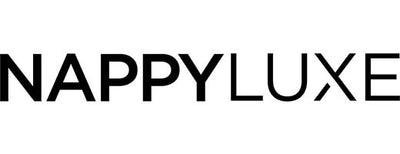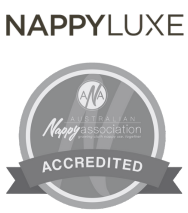How To Use Cloth Nappies With Your Newborn

If you’re thinking of using modern cloth nappies from when your baby first arrives, here’s what you need to know to start off the right way.
Using modern cloth nappies can seem daunting at first, especially when you add in all the unknowns that come with recovering from giving birth in those early newborn days - not to mention the sudden change in your lifestyle and sleeping pattern.
The sooner you start reusable cloth nappies, the sooner you benefit from the cost savings they can bring.
But remember that like your birth plan, things don’t always go the way you imagined and it’s a good idea to have a back up.
There’s nothing wrong with starting with disposable nappies if you need to, but if you’re wanting to commit to cloth from the go, here’s everything you need to know.
Why start using cloth nappies from newborn?
You can start using cloth nappies at anytime, there’s no rule about when is best to start.
Many parents make the switch when their baby is a toddler, or when on their third or fourth child.
Often the main driver for these parents is around the environmental benefits, or just how darn cute the nappies look.
However here are a few added benefits to starting cloth nappies from when your baby is a newborn:
- You’ll see the biggest cost savings - by starting with cloth straight away, you’ll speed up when you “break even” on your investment in cloth nappies - in our disposables vs cloth nappies cost comparison we estimate this to be when your baby is around 7 months old when you've started from newborn.
- You have the easiest clean up - for those concerned about the “icky” factor of cleaning up poo, we’ve got some good news for you. Babies who are exclusively breastfed and haven’t yet started solids can have their nappies thrown straight into the washing machine without any need to touch poo - jackpot. These babies have poo that is fully water-soluble, which means it gets spun away in the washing machine and goes to the sewerage with the rest of the water from the washing machine.
- You start as you mean to go on - the sooner you start using cloth nappies, the easier it is to continue as it’s all you really know.
What types of modern cloth nappies are there for newborns?
The main two different types of modern cloth nappies you can choose between include newborn sized cloth nappies and one-size-fits-most cloth nappies.
Newborn sized modern cloth nappies - these are made to fit smaller babies, roughly from 1 - 5 kg, and the main benefit is having a well-fitting nappy that is ready to use on your baby straight away. The main drawback of using newborn sized nappies is that they aren’t cost effective, most babies will be too big to fit them after the first month or two when they’re weighing more than 5kg. If you’re expecting an average or large baby, newborn sized cloth nappies may just be an unnecessary purchase.
One-size-fits-most (OSFM) modern cloth nappies - these are adjustable to fit an average sized newborn all the way up to toilet training age, roughly from 3.5kg - 18 kg. The main benefit is that they are very cost effective, as they grow with your baby and you reuse the same nappies again and again. The main drawback of these types of nappies is that if you give birth to a smaller than average sized baby, your baby may be too small to fit the nappies straight away.
Will my baby fit cloth nappies straight away from birth?
Unfortunately, it’s pretty impossible to know exactly how big your baby will be until he or she arrives.
If you’re happy with the extra expenditure and prefer to have a guarantee that your baby can go straight into modern cloth nappies, then newborn sized cloth nappies may be right for you.
If your baby is tracking average sized, and you’d prefer to wait and see, then you should be fine going straight for one-size-fits-most modern cloth nappies such as NappyLuxe.
If you plan to use one-size-fits-most nappies but your baby does arrive too small to fit them, you can always use some newborn sized disposables or Terry flat nappies as a backpack for a short time until your baby has grown a bit.
How do I know if my baby is too small for cloth nappies?
You will know if your baby is too small for the one-size-fits-most nappies if the leg elastics don’t sit flush against your baby’s skin.
There shouldn't be a gap, as this will allow poo and wee to escape, causing leaks and unnecessary extra washing.
How many nappies do I need for a newborn?
As a guide, if you’re wanting to use modern cloth nappies full-time on your baby, you’ll need around 24 nappies.
For part-time use, 12 nappies should suffice, but the decision is really up to you based on when you want to use them and how frequently you want to wash them.
However, newborn babies need more frequent nappy changes, up to 10 - 12 per day, compared to older babies who only need around 6-7.
This is because they generally wake, and poo, frequently during the night and therefore need multiple nappy changes around the clock. This is compared to older babies who can usually use the same nappy throughout the night.
Remember that the more cloth nappies you have on rotation, the less frequently you need to wash them.
How do I wash the nappies?
Our cloth nappy washing guide provides tips on how to wash nappies by putting them through a 3-step wash process:
- Dry pail - place dirty nappies in an airy basket
- First wash - wash in the washing machine for the first wash to remove the majority of the soiling. Do this every day or second day
- Second/main wash - put the nappies through a second wash to give them a thorough clean. Other clothing items can now be added. Do this every 3rd or 4th day.
As mentioned above, newborn exclusively breastfed poo nappies can go straight into the washing machine without the need to rinse.
Other tips and common mistakes to avoid
Get the fit and leg seal right - see our cloth nappy fit guide to ensure you’re fitting the nappy correctly. What is especially important for newborn babies is to make sure that the leg elastic sits flush against their skin. If your baby’s legs are too skinny for the leg elastic to sit flush, then they may not be big enough to fit the one-size-fits-most nappies just yet.
Only use one insert - NappyLuxe nappies each come with 2 inserts, a large and small insert. The small insert is perfect to use in isolation for newborn babies during their first few weeks. As soon as your baby is sleeping longer stretches, and started to do larger wees, you can switch to the larger insert to give that extra bit of absorbency. At some point when your baby has out-grown the newborn phase, you will need to start using both inserts combined to ensure there's enough absorbency.
Point the penis down - for baby boys, this is really important for both disposable and cloth nappy users. If you forget to point the penis down, it’s possible that the wee can spray straight out of the top of the nappy onto your baby's clothing.
Change frequently - all nappies (disposable and cloth) are recommended to be changed every 2 - 3 hours during the day. The exception is at night if your baby is sleeping long stretches and not pooping overnight anymore. If you're lucky enough to have a newborn who sleeps through the night, you can try using both NappyLuxe inserts combined to provide enough absorbency for the whole night. Once your baby has grown bigger, you may need additional absorbency in the form of cloth nappy insert booster packs to stay dry all night long.
Keep the umbilical cord outside the nappy - while your baby's umbilical cord stump is healing, try to keep it away from wee or poo as best you can. If the stump still sits just inside in the nappy, try folding down the nappy insert inside the nappy, leaving it unsnapped, so all that's touching the stump is the nappy cover.
These are our tips for how to correctly use cloth nappies with your newborn baby.
Shop Newborn Cloth Nappies NowBlog posts
How To Use Wool Nappy Covers At Night (Benefits & Wash guide)
Best Cloth Nappies Australia [What Features Do Top Brands Have In Common]
The 5 Top Uses For Cloth Wipes Revealed
Get 10% off your first order
Plus get notified about promotions, new releases and journal updates.





















